Corteva’s R&D yields new solutions for grassland management
|
Corteva Agriscience has recently gained approval from the UK’s regulatory authority for pesticides, Chemicals Regulation Division (CRD), for two new selective herbicides for use on grassland.
ProClova® XL is the long awaited clover safe herbicide! Containing a new active ingredient, Rinskor™, it controls key weeds in both newly sown leys and established grassland and has good safety to white clover. It can also be applied safely to leys containing red clover, but in the year after sowing.
It gives control of redshank, chickweed, docks and other weeds in newly sown grass plus clover leys. In established grassland it will be used at a higher rate to control docks, dandelions, buttercups, hogweed and cow parsley. This product will help establish grass plus clover leys where weeds are a threat and also preserve clover populations in established grassland where weeds become a problem.
ProGrass™ contains a new active ingredient for grassland use - Arylex™. This new product will give long-lasting control of a wide range of key broad-leaved weeds such as docks, nettles, buttercups, plantains and dandelions. It is also effective on tough to kill hogweed and cow parsley. It’s a fast acting formulation with a 7-day cutting interval making treatments between silage cuts and in rotational grazing systems more feasible.
It can be used on both grass that is cut and grazed, so is ideal for fields being used for zero grazing, silage, haylage, hay and grazing.
|
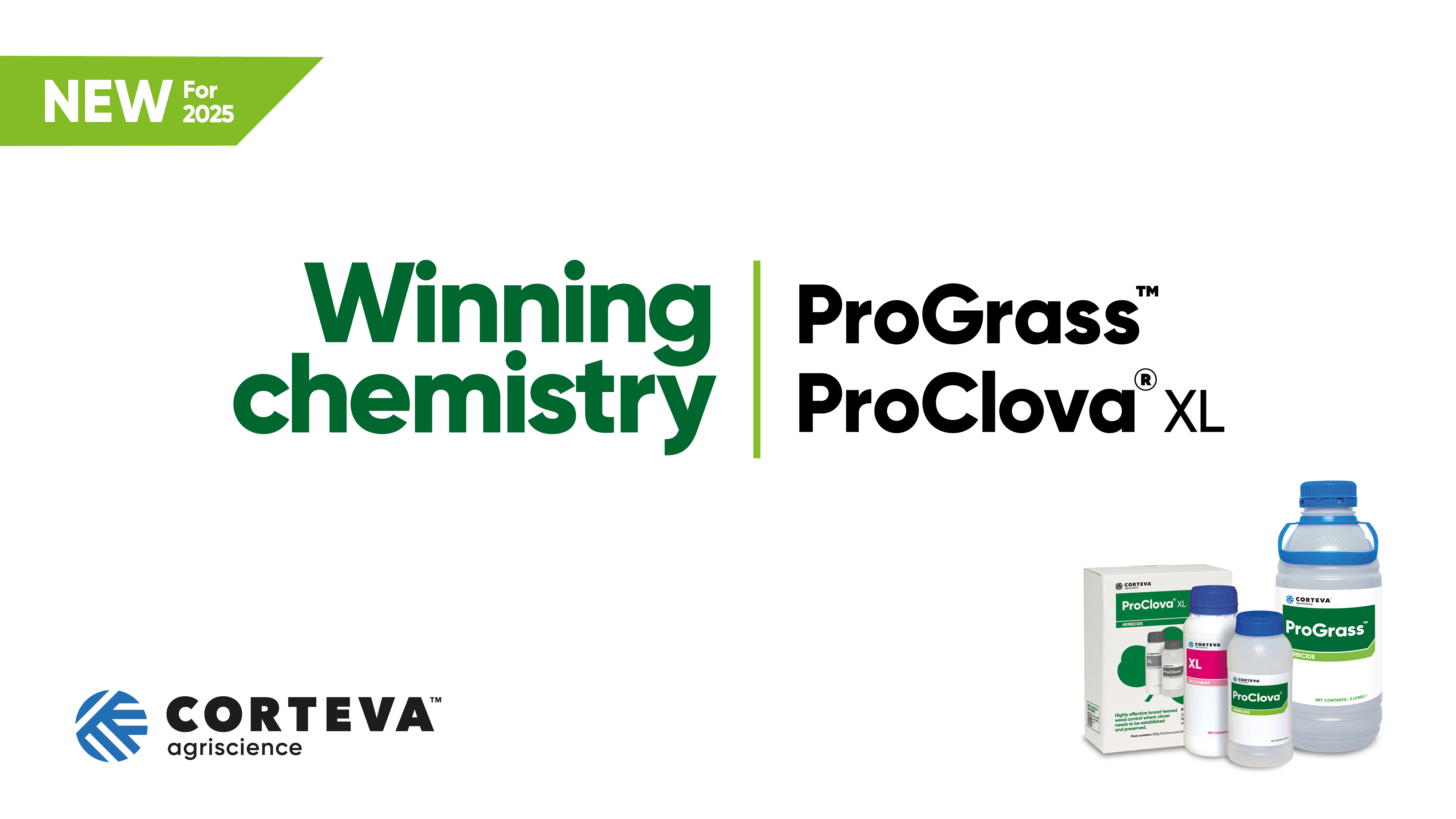
|
Drift reduction technology – a label requirement for ProGrass and ProClova XL
|
The labels states "HORIZONTAL BOOM SPRAYERS MUST BE FITTED WITH THREE STAR DRIFT REDUCTION TECHNOLOGY". Low drift spraying equipment should be used in accordance with the specific conditions outlined in the official three-star rating for that equipment, as detailed on HSE Chemicals Regulation Directorate’s website.
Air inclusion nozzles are the most likely solution for this. They reduce drift by creating larger droplets containing small bubbles of air. This coarser droplet enables the spray to travel accurately from nozzle to target. On impact, the droplet bursts leaving small droplets across the leaf surface. This leads to less drift and more deposit of product onto the target leaf. Travelling speed and water volume will determine the exact type of nozzle to use:
- Both ProClova XL and ProGrass must be applied in 200 litres of water/hectare.
- Optimal travelling speed when spraying grassland is typically in the range of 8 to 10kph depending on field conditions.
It's good practice to use drift reduction nozzles with our wider range of grassland herbicides too.
See the Spraying Low Water Volumes in Grassland video in the ‘How To’ section of the Corteva Forage App. If you haven't downloaded the app yet, you can do so here.
|
Weed management solutions in maize
|
Principal® Forte: A comprehensive grass and broad leaved weed herbicide with minimal need for additional herbicide tank mixing. The 480 g/ha dose rate delivers 245 g/ha dicamba + 30 g/ha nicosulfuron + 15 g/ha rimsulfuron. It also contains the crop safener isoxadifen.
Leystar®: A broad spectrum weed control solution containing fluroxypr, florasulam + clopyralid which is the preferred solution for mayweeds, thistles and docks. Now approved for tank mixing with nicosulfuron to enable a more comprehensive weed management approach. Great utility with a label that carries use on cereals, cereals under sown with grass, newly sown leys, established grassland and maize.
Starane® Hi-Load: The only straight fluroxypyr solution that has a label to support tank mixing. Particularly good on black nightshade, also cleavers, chickweed, fumitory, hemp nettle and forget-me-not.
|
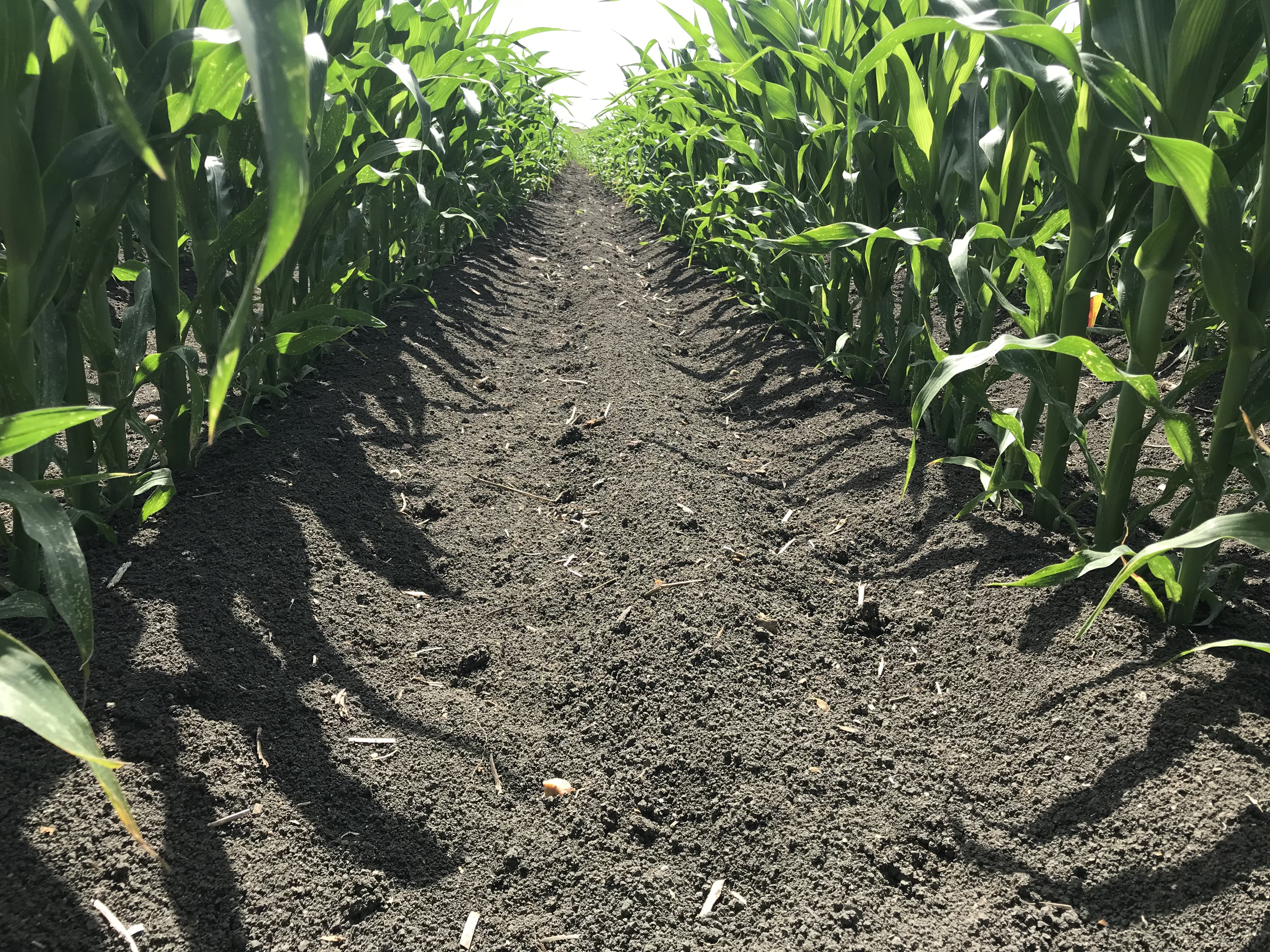
|
Sycamore seedlings in equine paddocks
|
Pony paddocks typically see flushes of sycamore seedlings in spring. Some sycamore seedlings contain the toxin hypoglycin A, which when eaten by horses or ponies, can cause the sometimes-fatal condition equine atypical myopathy.
Sycamore* is not a label weed for Corteva's grassland herbicides, but spot treatment with Grazon® Pro or a boom spray with ProGrass™ will give control of sycamore seedlings. For paddock owners who do not hold sprayer qualifications, then the product SBK Brushwood Killer can be used. Alternatively, you can employ a spray contractor to treat paddocks with a professional use herbicide.
Horse owners need to be aware of the consequential extended grazing intervals needed following the treatment of sycamore seedlings. As with the control of ragwort, it is necessary for the weed to have died and rotted down completely before animals graze the field again.
*Any recommendations for off-label or anecdotal control is only indicative and should not be considered a recommendation for use on the part of Corteva Agriscience. The user assumes full responsibility for use on these weeds.
|
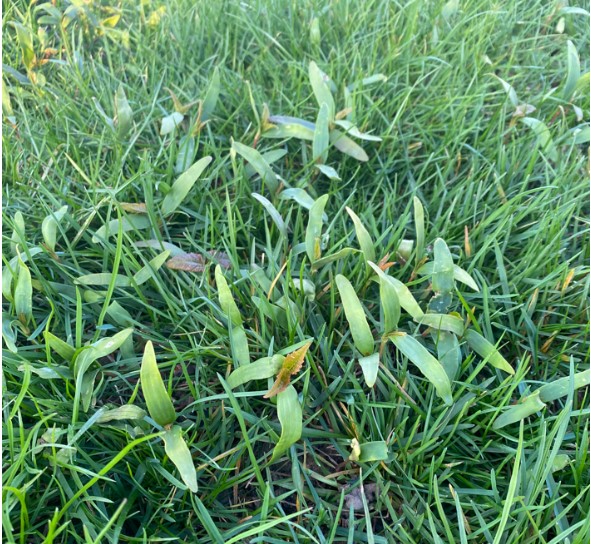
|
Chickweed in newly sown leys and established grassland
|
Early spring is the time of year when common chickweed and mouse-ear chickweed begin to emerge and smother grassland. Their growth habit allows them to rapidly colonise any gaps in the sward.
These weeds can be found in established grassland, often in damaged swards, or where slurry injectors open the sward allowing their establishment.
- Chickweed plants impact grass growth and can produce up to 1300 seeds.
- It only takes five to six weeks from germination to seed dispersal.
- Plants are capable of four to five generations a year.
Envy® contains fluroxypyr + florasulam and is ideal for controlling both common and mouse-eared chickweed. The label supports use in either newly sown leys or established grassland when targeting either common or mouse eared chickweed. Envy performs well across a range of temperatures.
- If conditions allow, spray Envy before the chickweed flowers.
- Envy has excellent grass safety.
- Envy is Rainfast in 2 hours.
- Envy has a post treatment stock exclusion period of just 7 days.
Application rates for chickweed:
1.0 L/ha in newly sown leys, or 1.5-2.0 L/ha in established grassland. Chickweed competes aggressively with grass for space, light, water and most importantly nutrients. If left uncontrolled, it can dramatically reduce presence of grass and following die-back can encourage other weeds, such as docks, to colonise the bare patches left behind.
|

|
PACTS results for 2025/26
|
Have you seen our PACTS® book yet? The latest maize PACTS results were published last month following a full programme of UK and Ireland trials in 2024. PACTS is an abbreviation for ‘Pioneer® Accurate Crop Testing System’ and refers to multi-location on-farm conducted trials that allow us to accurately describe the performance of the Pioneer maize hybrids we offer for sale.
|
Click here to download the 2025/26 edition of PACTS
|
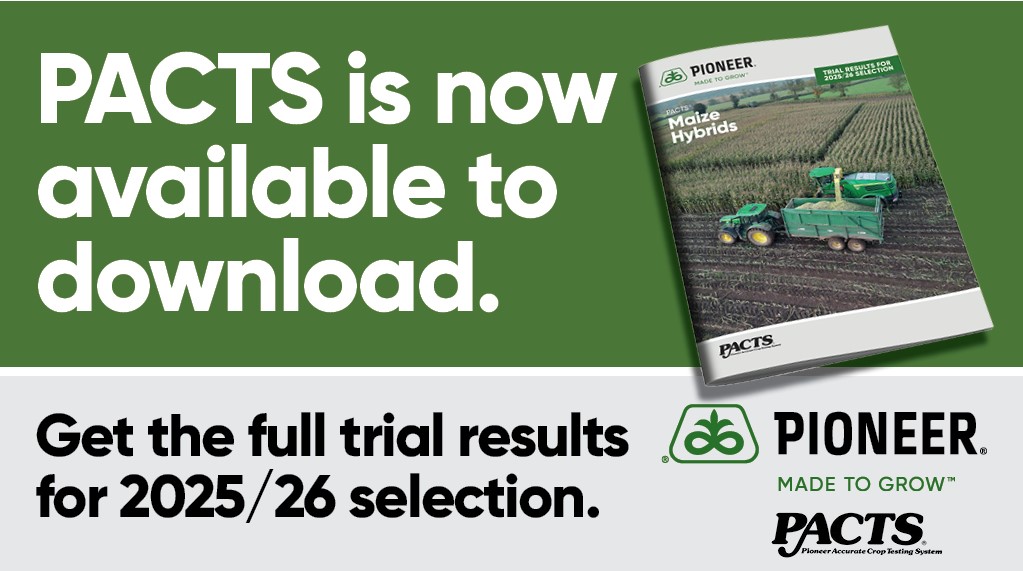
|
|
|
There are multiple key advantages of Pioneer Brand 1188 which is a multiple species/multiple strain grass silage inoculant.
The quality of grass silage is determined by numerous factors including fertiliser application rates and timings, grass quality at cutting time, weather preceding and during silage making, harvesting speed and clamp management practices, feed–out practices and the use of an effective additive.
The ability of bacterial strains to grow and dominate the fermentation of any grass silage depends on the quantity and types of water-soluble carbohydrates (sugars) present, the grass osmotic pressure, which is a consequence of the dry matter content, the pH levels as the fermentation proceeds, and the effectiveness of the bacterial strains and the rate.
The types of sugars (e.g. maltose, sucrose, cellobiose etc.) within grass plants vary widely depending on the proportion of different grass species within a ley i.e. perennial ryegrasses, timothy, clovers etc. One of the purposes of grass silage inoculants is to convert sugars to lactic acid more efficiently than would otherwise happen. Different inoculant products have a varying capability to utilise the multiple types of sugars found in grass. Pioneer Brand 1188 probably has the widest capability of any, see Table 1, which goes towards making it one of the most effective grass silage inoculants that can be applied to grass in the UK.
Table 1. Range of sugar types utilised by Pioneer Brand 1188 versus a leading single strain competitor product (source; Pioneer Brand Research).
|
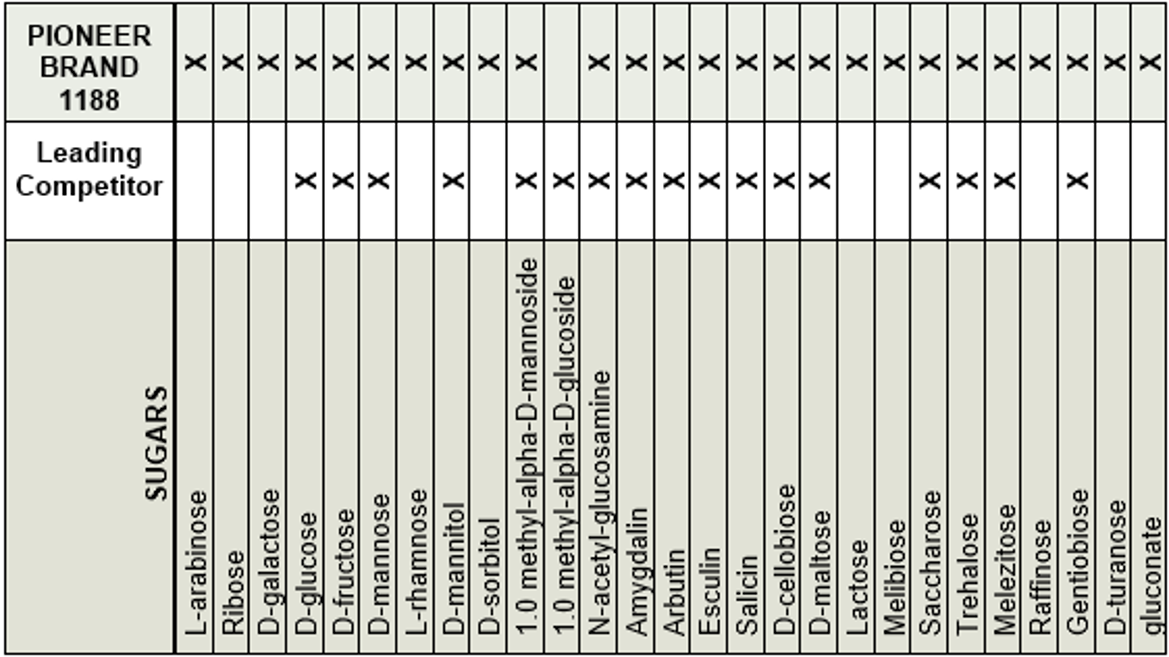
|
Instinct: lock in Nitrogen to boost maize yields
|
As a crop, maize has traditionally been under-fertilised, and this is largely due to it requiring a significant amount of nitrogen - around half - post flowering. Nitrogen stabilisers slow down the conversion of ammonium to nitrate, preventing nitrogen loss through leaching and denitrification. Trials using Corteva's Instinct® have shown a reduction in leaching of around 50%, and a reduction in denitrification through greenhouse gases of approximately 45%. This means nitrogen is kept in the soil for longer, and for a crop such as maize, this has a significant impact on yields as it is available to the plant when it is needed.
|
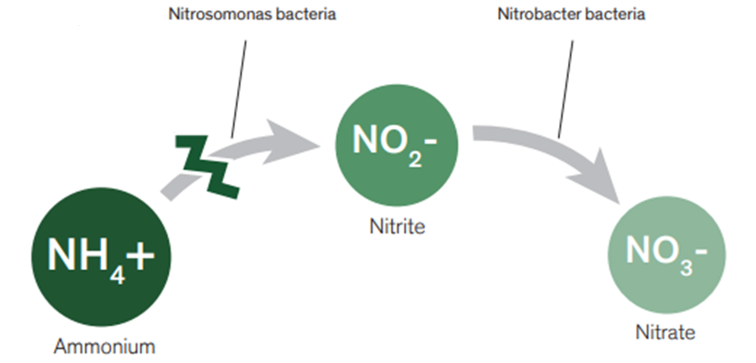
|
Increase maize yields with BlueN
|
BlueNTM is a nutrient efficiency biostimulant for use in a broad range of crops including maize. It contains Methylobacterium symbioticum, a bacteria found in nature, which fixes nitrogen from the air and converts it into usable nitrogen in the plant.
|
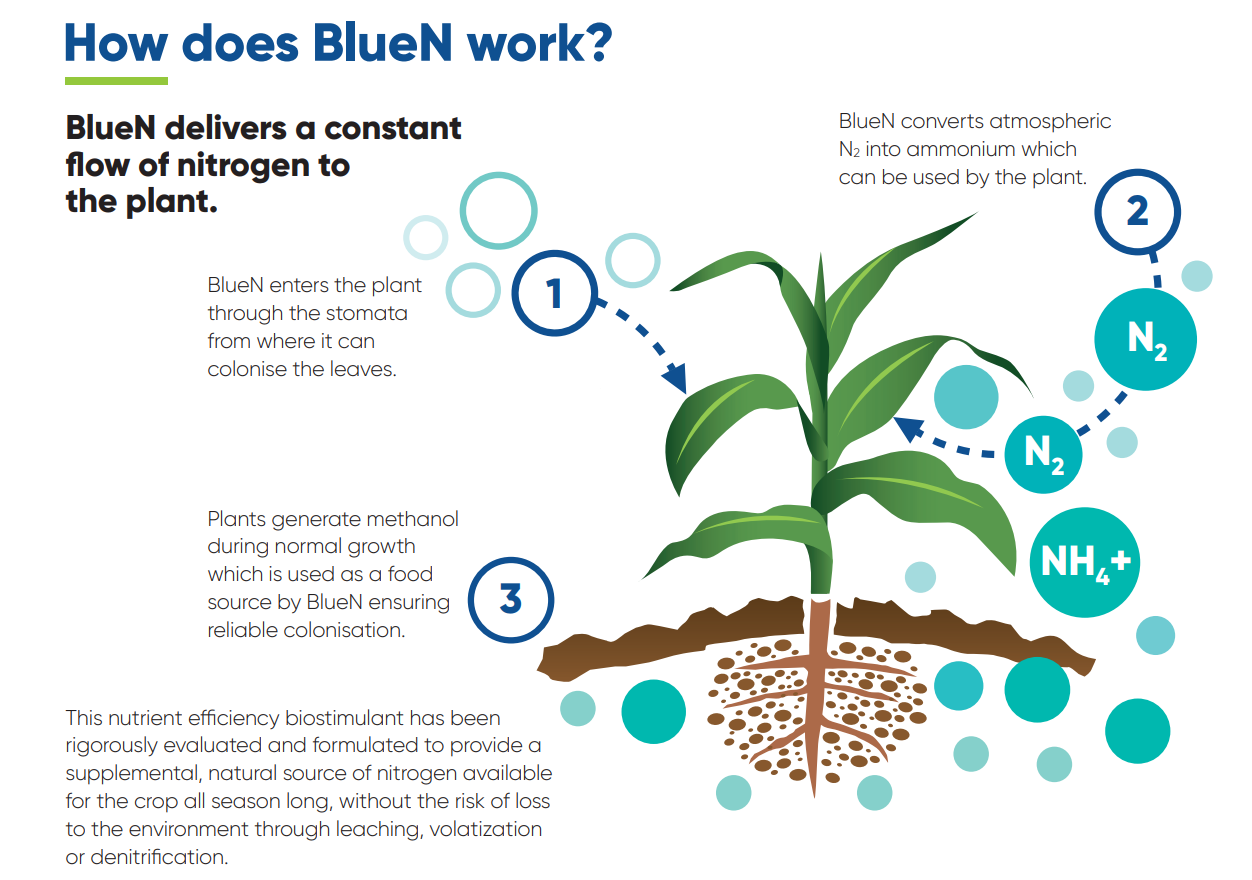
|
Increase fresh yield by 5t/ha with BlueN.
An independent trial carried out in Warwickshire last season showed a 5t/ha increase in fresh yield and a 2.8t/ha increase in dry matter yield with corresponding improvements in D values and metabolisable energy, consistent with other BlueN maize trials in 2024 season.
|
|
|
Team Corteva had a great time exhibiting at Kent Expo earlier this month. It was great to talk to so many of you about our solutions and hear about your experiences. Thank you to everyone who dropped by the Corteva stand to say hello.
We will keep you updated with upcoming events that we'll be exhibiting at in each edition of the Forage Agronomy Update.
|

|
|
|
Q: Are you able to give some more information on herbal leys and what species would be a good option if using ProClova XL?
A: We have seen some recovery post treatment on chicory and bird's foot trefoil in a newly sown ley situation. We are undertaking trials to assess effect on established populations and a wider range of species and will share that in due course.
Q: Would the addition of XL adjuvant to other grassland herbicides such as DoxstarPro enhance the level of weed control?
A: No. XL is only registered for use with ProClova and will not be available as a straight product.
Q: Can agronomy software packages delivering field recommendations deal the ProClova XL co-pack of two components with different label rates but just one MAPP number?
A: We are liaising with these companies so that modifications are made to manage this type of product approval.
Q: What level of control of fat hen and mouse eared chickweed can be expected with ProClova XL?
A: Fat hen control is circa 75%. Common chickweed control is circa 85%. Based on minimal data we would expect mouse-eared chickweed control to be circa 75%.
|
|
|
For all enquiries about our maize hybrids, please contact your local Forage Specialist or Forage and Seed Promoter. The contact details of your local contact can be found below.
|

|
For technical enquiries concerning Corteva herbicides, biostimulants and nitrogen stabilisers, please contact the hotline team using the contact details below. Or click here to find the contact details of your local area manager.
|

|
BASIS and NRoSO CPD points
|
2 BASIS points (1 crop protection and 1 personal development) will be awarded to those subscribing to the Forage Agronomy Update.
2 NRoSO points will be awarded for subscribing.
To receive your CPD points subscribe to the Forage Agronomy Update by clicking here.
|

|